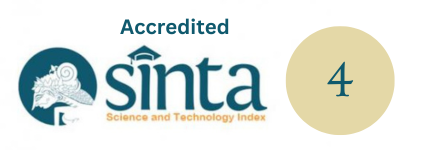Music Composition Bebarongan “Cepuk” | Tabuh Petegak Bebarongan “Cepuk”
DOI:
https://doi.org/10.59997/jurnalsenikarawitan.v1i1.150Keywords:
Petegak, Bebarongan, Gamelan, BaliAbstract
This musical composition's goal is to express creativity, as well as potential in the arts through musical art creation compositions in order to create quality art works. Cepuk is a product of tenun ikat handicrafts from Banjar Tanglad community of Nusa Penida, this woven fabric was previously only intended as wastra and kampuh (shawl) on sacred buildings and kamben for people who carry out special rituals in Tanglad Village area. The 'cepuk' woven fabric consists of several types, each type has magical elements and different uses in religious ceremonies, namely; cepuk ngawis, woven cloth used during the pitra yadnya ceremony (ngaben), cepuk tangi gede, a woven cloth used by the middle child whose all brothers and sisters died (cremation ceremony), cepuk liking paku (nails) are used by men during the tooth-filing ceremony, cepuk kecubung (amethysts) are used by women during tooth-filling ceremonies, cepuk sudamala which is a cepuk woven cloth used when cleansing oneself, and lastly, cepuk kurung (brackets) is a cepuk woven cloth used on ordinary day. The Cepuk actualization on the art work, manifested in the form of tabuh petegak bebarongan (instrument), using the concept of Tri Angga, pengawit (head), pengawak (body), and pengecet (feet). The medium used in this artwork is gong kebyar. This work is presented at the Natya Mandala building Indonesia Institute of The Arts Denpasar, supported by 21 traditional artists from Sekaa Gong Giri Kertha Yasa, Banjar Tanglad Nusa Penida, with a duration of 14 minutes.
Downloads
References
A.A.M.Djelantik. 1999. Estetika: Sebuah Pengantar. Bandung: Masyarakat Seni Pertunjukan Indonesia (MSPI).
Aryasa, IWM W.M. Dkk. 1985. Pengetahuan Karawitan Bali. Denpasar: Departemen Pendidikan dan Kebudayaan Bali.
Bandem, I Made. 1986. Prakempa Sebuah Lontar Gambelan Bali. Denpasar: ASTI Denpasar.
Hawkins, Alma M. 2003. Mencipta Lewat Tari. Terj. Y. Sumandiyo Hadi. Yogyakarta: Manthili.
Pardita, I Made Kayika. 2015. “Skrip Karya Seni Bebarongan Gringsing.” Institut Seni Indonesia Denpasar.
Sadguna, I Gede Made Indra. 2010. Kendang Bebarongan Dalam Karawitan Bali Sebuah Kajian Organologi. Yogyakarta: KANISIUS (Anggota IKAPI).
Santosa, Hendra; Saptono. 2016. “Gamelan Sistem Sepuluh Nada Dalam Satu Gembyang Untuk Olah Kreativitas Karawitan Bali.” Pantun 1(2): 85–96. https://jurnal.isbi.ac.id/index.php/pantun/article/view/747.
Saptono, Tri Haryanto, and Dru Hendro. 2019. “Greng Sebuah Estetika Dalam Kerampakan Antara Gamelan Dan Vokal.” KALANGWAN Jurnal Seni Pertunjukan 5(1): 29–38.
Sugiartha, I Gede Arya. 2015. “Pergulatan Ideologi Dalam Penciptaan Musik Kontemporer Bali.” Panggung 25(2): 121–36. https://jurnal.isbi.ac.id/index.php/panggung/article/view/3/5.
Sukerta, Pande Made. 2009. GONG KEBYAR BULELENG: Perubahan Dan Keberlanjutan Tradisi Gong Kebyar. Surakarta: Program Pascasarjana bekerjasama dengan ISI Press Surakarta.
Vitale, Wayne. 2002. “Balinese Kebyar Music Breaks the Five-Tone Barrier: New Composition for Seven-Tone Gamelan, Perspective of New Music.” Jstor 40(1): 5–69.
Yasa, I Gede Yoga. 2015. “Skrip Karya Seni Rangrang.” ISI Denpasar.
Yasa, I Ketut. 2018. “Angsel-Angsel Dalam Gong Kebyar.” Mudra Jurnal Seni Budaya 33(1): 85.








